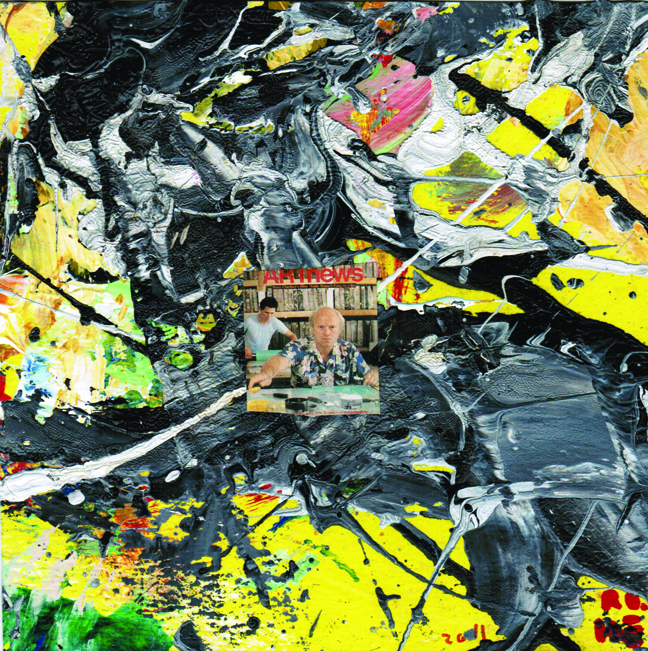I first really got to know Barnaby Ruhe as the actor who portrayed Jackson Pollock, while I did a much more minor turn as Clement Greenberg, in Bill Rabinovitch’s fantastic fiasco “Pollock Squared.” Ruhe is foremost a painter, while also practicing moving energy around as a healer, a shaman, and a boomerang thrower, he transfers his quick-witted dynamism into his handling of paint. Sometimes, he dresses the part to take on another character. His opus is as much about his character as it is about being a plastic visual artist.
His canvases are sometimes slapdash, less De Kooning than Morris Katz. Over the last few years, in a series of art history vignettes in the form of collages and painterly essays on boxes, Ruhe has tuned toward art history and momentarily veered away from the fun, party-time vanity his portrait marathons have sometimes engendered.
There was a great array to choose from among the exhibition at Dorfman Projects, including “Full Disclosure,” the Hunter S. Thompson piece. (The sometime poet wrote the piece for the catalog, which he composed right after being offered a series of choices in an email he read the morning after returning from California.) In a buffet of history, nothing was to be taken lightly from this man who channels other beings, very often, quite believably. Later, in the exhibition’s short run, Ruhe focused in on a very small work whose subject was not Kostabi but Qaddafi.
Fascinated as I am by Italo-Arabia, the colors of the two flags, the turnover chromatics from Mussolini to the present day, the wavering paint, and the almost defacement of the dictator’s countenance in this work speaks volumes. Then perhaps it should be remembered that at times, this man did as much good for his formerly impoverished land as the well-recorded evil which he has been immortalized by.
Now while giving a tour of NYC (to what seemed to be the Algerian Foreign Service Training Corps at the end of a hostile trip) this writer warmed them up with a story about giving a tour to terminal cancer patients. Followed by an offhanded mention that I wished to venture to post-Muammar Libya, and that furthermore I wished to survey the art, especially the Roman antiquities. I was told, “Go there and they will really take care of you.”
All the while, having read Ann Marlowe’s horrendous piece criticizing the post-conflict worthiness of visiting Tripoli to see what was there, made this international shopping mall correspondent all the more curious after seeing pictures of the treasures online: “Libya was a backwater during the empire…it is substandard.” What is she reviewing, a new Cuban deli in Miami Beach? She had just described the wonderful pop sensibility or surrealist juxtaposition of Qaddafi’s autos amidst antiquities and was now a disapproving art tourist. Or maybe she was being sarcastic rather than problematic? It surely has to be one of the most insulting and flippant pieces on the far-flung realms of art to be published by a major United States newspaper in sometime.
Back to Ruhe’s Michelangelo redux which was so Rubenesque so as not to be Buonorattian at all. It got me thinking. Research brought me to “Beyond the Candelabra,” a forthcoming HBO biopic on the ivory twinkle across the Sistine chapel, redone on the master bedroom’s ceiling of Wladziu Valentino’s now abandoned Las Vegas home. A descendant of the immortal Florentine supposedly painted it. Further, in order to recreate the life of the virtuoso, a re-staging of his funeral in Palm Springs took place in (of all places) Palm Springs with extras on hand such as photographer Jim Budman.
Now back to Thompson. This Ruhe work has a hallucinogenic, pop fluidity in its rippling suggestion of repeated images. In the truncated double image of Gonzo himself smoking, the palette seems taken from the carpeting of one of the themed Las Vegas hotels he was so famous for roaming the convention-filled corridors of.
Ruhe’s takes on Warhol and DeKooning left me baffled for quite a while. He takes on who the platinum wigged painter was as a spiritual entity—but then again, the art prince was really more of a Jonathan Swift: making a comment and moving on (until later waylaid). However, Ruhe’s works here are rather enjoyable as conversation pieces. They are stops on a tour as Ruhe integrates them into his/our consciousness which is deep enough for him to pay a visit to all of them, perhaps though just one at a time; pulling off the interstate to stay at the Rubens, the Dali or even the Frida Kahlo.

























